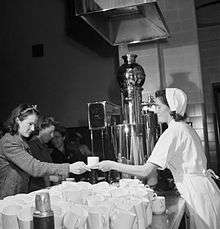Tea lady

A tea lady is a woman in an office or working environment, whose sole job is to provide beverages (chiefly traditionally tea, but other beverages including coffee and hot chocolate, now more common) and light snacks during the allocated tea break. Tea ladies are a mainly British custom. They entered the mainstream in the UK during the Second World War, when tea ladies were used in an experiment to boost efficiency in workplaces for the war effort. They had such a hugely positive effect on morale they became commonplace in all areas of work, mobile canteens even serving military units on exercises.[1] They were present in a works canteen or perhaps came round with a trolley, on which was usually a tea urn full of either hot tea or hot water, and perhaps a selection of cakes and buns.
Media
In the past they were often used as stereotypical figures in British comedy, with a tea lady usually portrayed as a harassed, overweight, middle aged woman in a uniform and cap, or as a very pretty recipient of all sorts of lewd comments from the workforce, as in the film Carry On at Your Convenience.
The character Mrs Doyle in the 1990s sitcom Father Ted, set in Ireland, had the role of a tea lady, and became known for relentlessly forcing the other characters to drink the tea she'd made for them, possibly a reference to the fact that the Irish are the biggest tea drinkers in the world averaging 4 to 6 cups per person per day.
Tea ladies in general were a frequent target of illusory "cuts" and "economies" in Yes Minister, frequently conjured up by Nigel Hawthorne's character Sir Humphrey Appleby, but a tea lady was only once seen onscreen during the whole five-series run of the show, sharing a lift with Jim Hacker and Sir Humphrey Appleby in the episode "The Skeleton in the Cupboard".
In Australia, there was a popular sitcom called The Tea Ladies, based on a similar British production.
In association football, media and fans often blame "the tea lady" for leaking information about player transfers to the public, regardless of whether or not team managers actually have a tea lady.
Demise
This occupation began to die out in the late 1970s to early 1980s when tea ladies began to be replaced by private catering firms and vending machines, as businesses expanded and women moved into different jobs. The tradition of the tea break, from which the role of tea lady rose, has itself declined, also offering a possible explanation why tea ladies are not commonly found today.
A survey carried out by the group National Opinion Polls in 2005 showed that of those workers who drink more than four cups of tea a day, only 2% of them receive it from a tea lady,[2] whereas 66% received it from an urn, and 15% from a vending machine.
See also
References
- ↑ "Your Mobile Canteen in Action". Imperial War Museum. Retrieved 2010-07-25.
- ↑ "Research carried out for tea4health in April/May 2005 by NOP on 1,000 adults.". UK Tea Council. 2005. Retrieved 2007-02-17.
